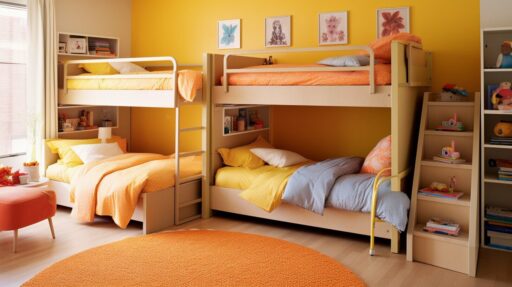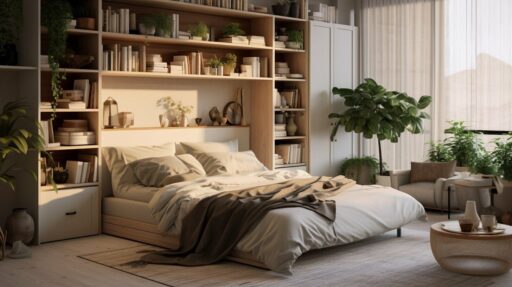
Types of Beds and Bed Features
Are you looking for the perfect bed to enhance your sleep and upgrade your bedroom? Explore the various types of beds and their unique features to find the perfect fit for you.

There are various types of beds available in the market, each with its own unique features and designs. When choosing a bed, it is important to consider the size that best suits your needs. The sizes range from twin, twin XL, full, queen, king, California king, and various specialty sizes for specific purposes.
In terms of bed styles, there are many options to choose from. Some popular styles include daybeds, futons, waterbeds, air beds, bookcase beds, Murphy beds, convertible beds, four-poster beds, low poster beds, pencil poster beds, half poster beds, round beds, divan beds, ottoman beds, canopy beds, contemporary canopy beds, half tester beds, panel beds, hanging beds, enignum beds, magnetic floating beds, sonic beds, rocking beds, wave beds, hammocks, and upholstered beds.
Bed frames also come in different styles, such as platform beds, adjustable beds, poster beds, low profile beds, mission beds, panel beds, sleigh beds, captains beds, daybeds, bunk beds, loft beds, futons, trundle beds, and more.
Key Takeaways:
- Consider the size of the bed that best suits your needs, ranging from twin to California king and specialty sizes.
- Explore the wide variety of bed styles available, including daybeds, canopy beds, and upholstered beds.
- Choose a bed frame that complements your style and preferences, such as platform beds or adjustable beds.
- Factors to consider when selecting a bed include size, style, design, and functionality.
- Find the perfect bed to enhance your sleep and upgrade your bedroom by considering your individual preferences and needs.
Different Bed Sizes to Suit Your Needs
Beds come in various sizes to suit different needs, from twin beds for solo sleepers to California king beds for those who prefer extra space. Choosing the right size is crucial for a comfortable sleep experience. Here’s a closer look at the different bed sizes available:
Twin
The twin bed, also known as a single bed, is the smallest standard bed size. It measures 39 inches wide and 75 inches long, making it ideal for children’s rooms, guest rooms, or small spaces.
Twin XL
The twin XL bed is similar to the twin bed in width but offers extra length, measuring 39 inches wide and 80 inches long. It is commonly found in college dormitories and is a popular choice for taller individuals.
Full
The full bed, also known as a double bed, offers more sleeping space with a width of 54 inches and a length of 75 inches. It can comfortably accommodate a single sleeper or a couple.
Queen
The queen bed is a popular choice for couples or individuals who prefer extra space. It measures 60 inches wide and 80 inches long, providing ample room to stretch out and move around comfortably during sleep.
King
The king bed is the largest standard size and is ideal for those who want maximum space while sleeping. It measures 76 inches wide and 80 inches long, making it perfect for couples or individuals who prefer a more spacious sleeping area.
California King
The California king bed is slightly narrower but longer than a standard king bed, measuring 72 inches wide and 84 inches long. It is a great choice for taller individuals who need the extra length.
Additionally, there are specialty bed sizes available for specific purposes, such as cribs for infants, bunk beds for kids, and adjustable beds for those with specific medical needs. Consider your individual requirements and preferences when selecting the perfect bed size.
Exploring Different Bed Styles and Designs
When it comes to bed styles, the possibilities are endless. From classic four-poster beds to contemporary canopy beds, there’s a style to suit every preference. Whether you’re looking for a statement piece or a functional design, the variety of bed styles available ensures that you can find the perfect fit for your bedroom.
One popular option is the daybed, which combines the functionality of a sofa and a bed. Daybeds are versatile and can be a great addition to a guest room or a small space where maximizing functionality is key. Futons are another versatile choice, offering the flexibility to convert between a sofa and a bed, making them ideal for multi-purpose rooms.
For those who prefer a luxurious and unique sleeping experience, waterbeds and air beds are worth considering. Waterbeds provide gentle support and can be temperature-controlled, while air beds allow for adjustable firmness. These types of beds can provide a truly personalized sleeping experience.
If you’re looking for a bed that offers both functionality and storage, bookcase beds are a great option. These beds feature built-in bookshelves, allowing you to display your favorite books or decorative items while maximizing space. Murphy beds, on the other hand, are perfect for small spaces as they can be folded up against the wall when not in use, providing extra floor space.

- Canopy beds add a touch of elegance and drama to any bedroom.
- They create a cozy and intimate sleeping space.
- Canopy beds can be styled with curtains, creating a sense of privacy and luxury.
- They come in a variety of designs, from classic to contemporary canopy beds.
- The four-poster design provides a sturdy and stable structure.
When it comes to bed styles, it’s important to choose one that reflects your personal style and meets your needs. Whether you prefer the timeless charm of a four-poster bed, the sleek and modern design of a platform bed, or the space-saving functionality of a Murphy bed, there’s a style for everyone. Consider the size, style, design, and functionality when selecting your perfect bed, and transform your bedroom into a comfortable and stylish sanctuary.
| Bed Style | Description |
|---|---|
| Daybeds | Versatile bed that combines the functionality of a sofa and bed. |
| Futons | Flexible design that can convert between a sofa and bed. |
| Waterbeds | Bed filled with water for a unique sleeping experience. |
| Air beds | Beds with adjustable firmness for personalized comfort. |
| Bookcase beds | Beds with built-in bookshelves for added storage. |
| Murphy beds | Beds that can be folded up against the wall to save space. |
| Canopy beds | Beds with a frame and curtains, adding elegance and drama. |
| Upholstered beds | Beds with fabric-covered headboards for added comfort. |
Bed Frames and Their Features
A sturdy and stylish bed frame is essential for a comfortable sleep experience. Explore different types of bed frames, such as platform beds and adjustable beds, to find the perfect fit for your bedroom. Platform beds are a popular choice due to their sleek and modern design.
Platform beds have a minimalist look with a low profile, providing a contemporary aesthetic. They are designed to support your mattress without the need for a box spring, making them a practical and cost-effective option. With various materials, such as wood, metal, or upholstered frames, you can find a platform bed that complements your bedroom decor.
Another option to consider is an adjustable bed frame, which allows you to customize your sleeping position for optimal comfort. These frames often come with features like adjustable head and foot positions, massage settings, and even built-in USB ports for convenience. Adjustable beds are ideal for individuals with specific sleep needs or those who enjoy lounging in bed while reading or watching TV.
| Type of Bed Frame | Features |
|---|---|
| Platform Bed | – Sleek and modern design – No need for a box spring – Available in various materials |
| Adjustable Bed | – Customizable sleeping positions – Massage settings – Built-in USB ports |
When choosing a bed frame, consider factors such as the size of your bedroom, your preferred style, and the functionality you desire. Whether you opt for a platform bed or an adjustable bed, investing in a quality bed frame will enhance your sleep experience and add a touch of style to your bedroom.

Choosing the right bed involves considering several factors, such as the size that fits your space, the style that matches your aesthetic, and the functionality that suits your lifestyle. Let’s delve into each of these factors to help you make an informed decision.
Size
The size of your bed is crucial for a comfortable and functional sleep experience. Measure your bedroom space to determine the appropriate bed size. Common sizes include twin, twin XL, full, queen, king, and California king. Additionally, specialty sizes are available for specific needs, such as cribs for infants or adjustable beds for medical purposes.
Style and Design
Your bed should complement the overall style and design of your bedroom. Consider your personal preference and the existing decor. There is a wide range of bed styles and designs to choose from, including daybeds, canopy beds, and upholstered beds, among others. Each style offers its own unique aesthetic, allowing you to create the desired ambiance in your bedroom.
Functionality
Functionality is another important factor to consider when selecting a bed. Think about your specific needs and lifestyle. For example, if you require extra storage space, consider beds with built-in drawers or shelves. If you frequently have guests staying over, a sofa bed or a trundle bed could be a practical choice. Evaluate the various features and options available to find a bed that suits your functional requirements.
By considering these factors – size, style, design, and functionality – you can make an informed decision when choosing the perfect bed for your needs. Remember, your bed is not just a piece of furniture; it is a key element in creating a comfortable and inviting sleep environment.
| Size | Dimensions (inches) |
|---|---|
| Twin | 39 x 75 |
| Twin XL | 39 x 80 |
| Full | 54 x 75 |
| Queen | 60 x 80 |
| King | 76 x 80 |
| California King | 72 x 84 |

Choosing the right bed is a personal decision that should take into account your comfort, style, and unique needs. Don’t rush the process; take your time to research and explore different options. Remember, a good night’s sleep starts with the right bed.
- Consider your bedroom space and measure it to determine the appropriate bed size.
- Take into account your personal style and the overall design of your bedroom when choosing a bed.
- Think about your lifestyle and specific functional needs to ensure the bed you choose fits your requirements.
Canopy Beds: Adding Elegance and Drama to Your Bedroom
Create a romantic and luxurious atmosphere in your bedroom with a stunning canopy bed. These beds add a touch of elegance and drama to any space. With their distinct design, canopy beds are not only functional but also serve as a statement piece in your bedroom.
Canopy beds are known for their four posts and a frame that supports a fabric or drapery overhead. This creates a beautiful and intimate space within your bedroom. Whether you prefer a traditional or contemporary look, canopy beds come in a variety of styles to suit your personal taste.

From classic designs with intricate carvings to more modern options with clean lines, a canopy bed can instantly transform the ambiance of your bedroom. The draped fabric adds a layer of privacy and creates a cozy cocoon-like environment, perfect for relaxation and a restful night’s sleep.
With a canopy bed as the centerpiece of your bedroom, you can easily elevate the overall aesthetic of the space. Whether you choose a bold and dramatic color for the drapes or opt for a neutral tone for a subtle touch, these beds offer endless possibilities for customization.
Create a Stylish Sanctuary
Transform your bedroom into a stylish sanctuary by incorporating a canopy bed into your design. The combination of the canopy’s height and the flowing fabric adds a sense of grandeur and sophistication. It provides a focal point that anchors the room and creates a cohesive and inviting atmosphere.
| Benefits of Canopy Beds |
|---|
| 1. Enhance the overall aesthetic of your bedroom |
| 2. Create a sense of privacy and intimacy |
| 3. Add a touch of luxury and elegance |
| 4. Provide a cozy and relaxing sleeping environment |
Whether you choose a traditional canopy bed with ornate details or a contemporary canopy bed with a sleek and minimalistic design, you can create a bedroom that reflects your personal style and taste. So why not indulge in the elegance and drama of a canopy bed and transform your bedroom into a dreamy retreat?
Platform Beds: Sleek and Modern Bedroom Solutions
If you prefer a sleek and modern look for your bedroom, a platform bed is the perfect solution. With their minimalist design, platform beds offer both style and functionality. These beds are characterized by their low-profile frames, which give a contemporary and streamlined appearance to any bedroom.
One of the key features of platform beds is that they don’t require a box spring, making them a cost-effective choice. Instead, they have a sturdy platform or slats that support the mattress directly, providing excellent support and even weight distribution.
Platform beds come in a variety of materials, including wood, metal, and upholstered options. Wood platform beds add warmth and natural beauty to the room, while metal platform beds offer a sleek and industrial look. Upholstered platform beds provide a touch of luxury and softness, with options for various fabrics and colors to suit your personal style.

| Benefits of Platform Beds | Drawbacks of Platform Beds |
|---|---|
| Modern and stylish design | May have limited storage options |
| Saves space with its low-profile design | Some models may require assembly |
| No need for a box spring, reducing costs | May have a firmer feel due to the lack of box spring |
| Provides excellent mattress support and durability | May not be suitable for people with mobility issues |
If you’re looking to create a sleek and modern bedroom, a platform bed can be the centerpiece of your design. Its clean lines and minimalist aesthetic will elevate the overall look and feel of your space. Whether you prefer a wood, metal, or upholstered platform bed, you’ll find a wide variety of options to choose from to suit your taste and budget.
Platform beds offer the perfect blend of style and functionality, making them an excellent choice for any modern bedroom.
Bunk Beds: Maximizing Space and Fun for Kids’ Rooms
Bunk beds are a great option for kids’ rooms, offering space-saving solutions and a sense of adventure. Discover the different bunk bed designs and safety features to create the perfect setup for your children.
When it comes to bunk bed designs, there are various options available to suit different preferences and room sizes. From classic twin-over-twin bunk beds to stylish loft beds with built-in desks or play areas, you can find a design that meets your specific needs. Some bunk beds even feature themes like princess castles or pirate ships, adding an extra element of fun to your child’s room.
Safety is of utmost importance when it comes to bunk beds. Look for features such as sturdy construction, guardrails on the top bunk, and wide ladder steps for easy access. It’s also a good idea to ensure that the bunk bed meets safety standards set by organizations like the Consumer Product Safety Commission (CPSC).
| Bunk Bed Type | Features |
|---|---|
| Standard Twin-over-Twin Bunk Bed | Simple design, suitable for small rooms |
| Loft Bunk Bed | Offers additional space underneath for a desk, play area, or storage |
| Futon Bunk Bed | Includes a futon or convertible sofa on the bottom bunk, providing extra seating or a guest bed |
| L-shaped Bunk Bed | Forms an L-shape, ideal for corner placement and maximizing space |
| Trundle Bunk Bed | Features a trundle bed that can be pulled out from under the bottom bunk, providing an extra sleeping space |
By choosing the right bunk bed for your kids’ room, you can maximize space while creating a fun and functional environment. Whether you go for a traditional twin-over-twin bunk bed or opt for a loft bed with added features, your children are sure to love their new sleeping arrangement.

- Space-saving design.
- Various designs and themes to choose from.
- Sturdy construction for safety.
- Guardrails and easy-to-climb ladder steps.
- Meets safety standards set by organizations like CPSC.
Investing in bunk beds is not only practical but also adds a touch of excitement to your children’s room. With their versatility and ability to create extra space, bunk beds are the perfect solution for any kids’ room.
When space is limited, Murphy beds offer a clever and stylish solution. These beds can be easily folded away, providing functional living spaces during the day. Murphy beds are designed to maximize space and efficiency, making them ideal for small apartments, guest rooms, or multipurpose rooms. One of the key features of Murphy beds is their ability to seamlessly blend into any room decor. They come in a variety of styles and designs, ranging from traditional to modern, ensuring that you can find the perfect fit for your space. Whether you prefer a classic wood finish or a sleek, contemporary look, there’s a Murphy bed style that will complement your aesthetic. In addition to their space-saving capabilities, Murphy beds are also known for their superior craftsmanship and durability. These beds are built to last, with high-quality materials and expert construction. You can rest easy knowing that your Murphy bed will provide a comfortable and reliable sleeping solution for years to come. To further enhance the functionality of your Murphy bed, you can opt for additional features such as built-in storage or desk space. These additions allow you to make the most of your available space, providing storage solutions and work areas that can be conveniently tucked away when not in use. In conclusion, Murphy beds are a practical and stylish choice for anyone looking to maximize space in their home. With their ability to fold away and blend seamlessly into any room, they offer a versatile solution for small living spaces. Invest in a Murphy bed and transform your room into a functional and comfortable space that meets all your needs.
| Murphy Beds | Benefits |
|---|---|
| Space-saving | Maximize available space in small rooms or apartments |
| Stylish | Variety of designs and finishes to complement any decor |
| Durable | Built to last with high-quality materials |
| Multi-functional | Additional features like built-in storage or desk space |

Finding the perfect bed is essential for a restful sleep and a comfortable bedroom. Consider the different types, sizes, and features available to find the ideal bed that meets your needs and enhances your living space.
There are various types of beds available in the market, each with its own unique features and designs. When choosing a bed, it is important to consider the size that best suits your needs. The sizes range from twin, twin XL, full, queen, king, California king, and various specialty sizes for specific purposes.
In terms of bed styles, there are many options to choose from. Some popular styles include daybeds, futons, waterbeds, air beds, bookcase beds, Murphy beds, convertible beds, four-poster beds, low poster beds, pencil poster beds, half poster beds, round beds, divan beds, ottoman beds, canopy beds, contemporary canopy beds, half tester beds, panel beds, hanging beds, enignum beds, magnetic floating beds, sonic beds, rocking beds, wave beds, hammocks, and upholstered beds.
Bed frames also come in different styles, such as platform beds, adjustable beds, poster beds, low profile beds, mission beds, panel beds, sleigh beds, captains beds, daybeds, bunk beds, loft beds, futons, trundle beds, and more.
Overall, when selecting a bed, it is important to consider factors such as size, style, design, and functionality to find the perfect bed for your needs and preferences.
FAQ
What are the different types of beds available in the market?
There are various types of beds available, including daybeds, futons, waterbeds, air beds, bookcase beds, Murphy beds, convertible beds, four-poster beds, low poster beds, pencil poster beds, half poster beds, round beds, divan beds, ottoman beds, canopy beds, contemporary canopy beds, half tester beds, panel beds, hanging beds, enignum beds, magnetic floating beds, sonic beds, rocking beds, wave beds, hammocks, and upholstered beds.
What sizes do beds come in?
Beds come in different sizes to suit your needs. The sizes range from twin, twin XL, full, queen, king, California king, and various specialty sizes for specific purposes.
What are some popular bed frame styles?
Popular bed frame styles include platform beds, adjustable beds, poster beds, low profile beds, mission beds, panel beds, sleigh beds, captains beds, daybeds, bunk beds, loft beds, futons, and trundle beds.
What factors should I consider when choosing a bed?
When choosing a bed, it is important to consider factors such as size, style, design, and functionality. These factors will help you find the perfect bed that meets your needs and preferences.
What are canopy beds and what are their benefits?
Canopy beds are beds that feature a fabric or decorative covering over the top. They add elegance and drama to your bedroom, and there are contemporary canopy bed options available.
What are platform beds and why are they popular?
Platform beds are sleek and modern bedroom solutions. They provide a minimalistic look, and their low-profile design is popular among those seeking a contemporary style.
How can bunk beds maximize space in kids’ rooms?
Bunk beds are a great option for kids’ rooms as they maximize space by stacking beds vertically. They also create a fun environment for children and are available in different styles and designs.
What are Murphy beds and why are they practical?
Murphy beds are space-saving solutions that can be folded up and hidden when not in use. They are practical for smaller spaces or multifunctional rooms where space optimization is crucial. They also come in various stylish designs.
